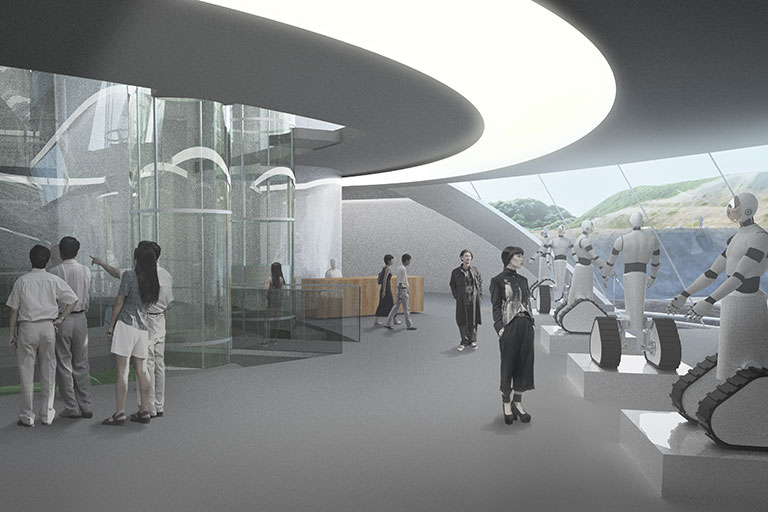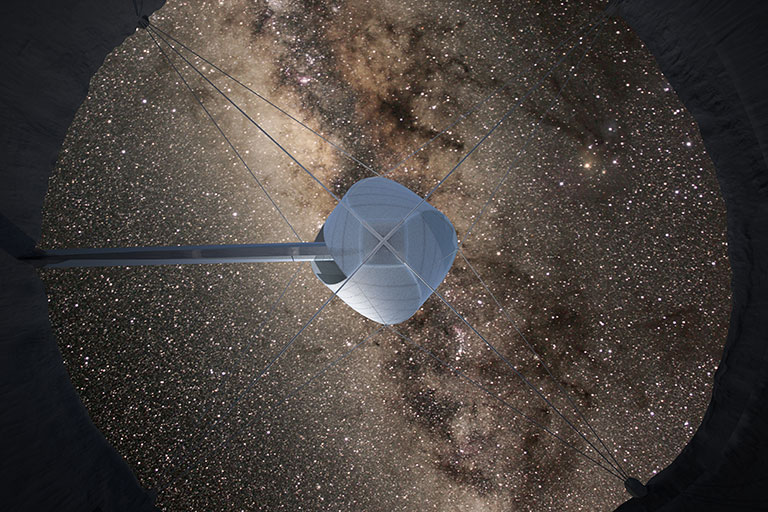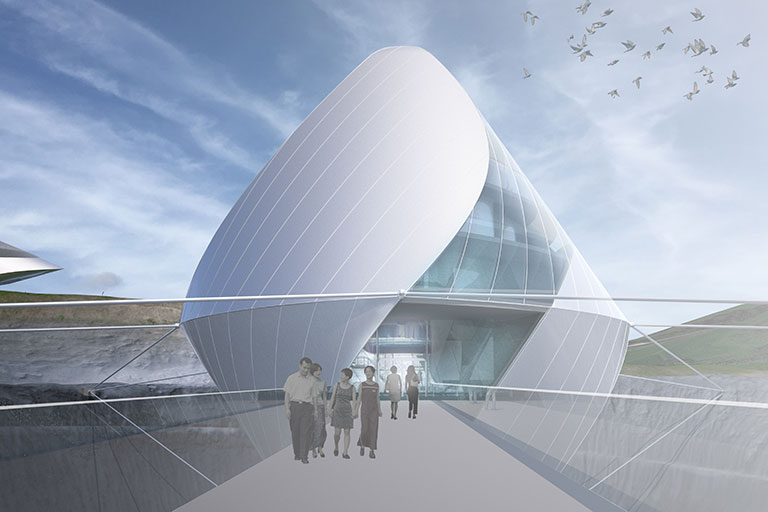The Avatar X space exploration campus in Japan will feature a futuristic robotics research facility suspended on steel cables over a moon-like crater
A pioneering space technology research campus, which will be used as a test field for a consortium of global tech companies, is due to break ground in Japan in 2020. The project is a partnership between ANA Holdings Inc. and Japan Aerospace Exploration Agency (JAXA) – both experts at launching vehicles into the atmosphere – and is part of Avatar X, a collaborative program for the advancement of space exploration and development.
Avatar X has identified three areas that will benefit from the campus’ research: remote construction in space, operation and maintenance of space stations and facilities from Earth, and space-based entertainment and travel for the general public.
“The overall structure looks like the wheel of a bicycle, which is laid onto the crater, and the building itself forms the central hub and is supported on steel cable ‘spokes’, forming a ‘tensegrity’ structure.”
Masayuki Sono, project architect
Oita is a coastal prefecture on Japan’s Kyushu Island, and the former mining site already resembles the lunar surface. The new campus will consist of several buildings as well as a moon simulation terrain, which will be used to experiment with the remote semi-autonomous construction of lunar surface habitats using avatar robots.
Clouds Architecture Office – a New York firm known for the Staten Island 9/11 memorial, and for working with Nasa to develop the Mars Ice Home – has completed concept designs for a masterplan and three buildings at the Oita campus: a research and development centre, a moon environment simulator, and the Avatar X lab building, which will be situated at the heart of the campus floating above a moon-like crater.
 The Avatar-X centre will house a state-of-the-art robotics research facility
The Avatar-X centre will house a state-of-the-art robotics research facility
Masayuki Sono, project architect and co-founder of Clouds Architecture Office, comments: “We started with a master plan of the entire complex. Since activities inside and around craters will be critical in the lunar surface exploration, and also due to existing topography, a large crater that simulates lunar environment was placed at the centre of the site.
“All facilities are positioned around the crater in radial organisation, and the central Avatar X lab contains a visitor centre, avatar simulation and display, a research facility and other public amenities. In order to control and monitor test activities that take place inside and around the crater, the lab is suspended in the middle of the crater, creating an inspirational symbol.”
The design for the building is intentionally iconic, expressing the pioneering spirit of flight by utilising construction techniques gathered from space architecture and aviation. “The form of the floating structure was informed by pressure vessels common in space architecture, which tend to be cylindrical in shape,” Masayuki explains. “We wanted to convey the innovative spirit and energy of the space age.”
 Steel cables will suspend the centre over a simulated moon crater
Steel cables will suspend the centre over a simulated moon crater
The cutting-edge research facility will be formed from semi-opaque and transparent panels of fluoropolymer membrane wrapped around a steel frame. Partitions will be made of carbon fibre, with honeycomb floor plates and fibre-reinforced plastic trims all designed to reduce weight.
Project team member and Associate Professor at the University of Tokyo, structural engineer Jun Sato, explains the design further: “The overall structure looks like the wheel of a bicycle, which is laid onto the crater, and the building itself forms the central hub and is supported on steel cable ‘spokes’, forming a ‘tensegrity’ structure. Here, a set of compression elements are opposed and balanced by a continuous tensile force, creating internal prestress that stabilises the entire structure.
“The spindle-type steel hub is a double quadrangular pyramid, 40 metres high, with a convex frame that can work as compression elements so that some beams inside this hub can be tension elements, and the structure becomes lightweight.”
“After examining various material options, due to complex multiple criteria, steel was chosen as the most feasible and proven system to realise the unique design.”
Masayuki Sono, project architect
The project is moving forward into the next phase, with construction expected to start in 2020, when the chosen site will be excavated and shaped to look like a crater on the moon.
“For the structural calculations of the Avatar X lab building we should consider gravity, horizontal and vertical vibration due to earthquakes and wind, soft ground conditions and thermal shrinkage of the cables,” says Jun Sato. “I propose to insert leaf springs on the edges of the cables – something which is commonly used for the suspension in wheeled vehicles.”
 Semi-opaque and transparent panels will fit around a steel frame to form the robotics centre
Semi-opaque and transparent panels will fit around a steel frame to form the robotics centre
Architect, Masayuki Sono elaborates: “The basic organisation of the lab is developed with a highly efficient stainless-steel suspension cable configuration. It is composed of symmetrical geometry of developable surface, with the concept of low mass/high performance which are critical for the design in outer space.
“With the application of a lightweight membrane enclosure system it optimises structural attributes and wind resistance, forming a dynamic spiral space. After examining various material options, due to complex multiple criteria, steel was chosen as the most feasible and proven system to realise the unique design.”
Avatar X hopes to begin testing avatars in Low-Earth Orbit in the mid-2020s, and the other-worldly robotics research lab will certainly be a unique symbol, representing the leading edge of technological development, which will help humans to live and work in space.
Images: Clouds Architecture Office